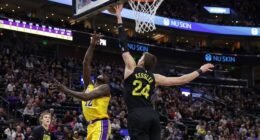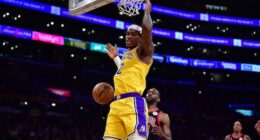Kobe Bryant had a spectacular individual season in the midst of the Lakers’ season woes. It was hard to imagine that this was his seventeenth year as a professional by the way he played the game and willed his team to the playoffs. This season was bittersweet for the Mamba as the Lakers’ hero fell in the closing minutes of the team’s third to last regular season game with a ruptured Achilles. While Kobe left that game in warrior-like fashion (on his own two feet, after nailing two clutch free throws), he would miss the postseason, where his presence was ultimately missed.
Regular Season Grade: A
Kobe had his fourth best shooting season of his career this year, shooting 46.3 percent from the field. He had several record-breaking performances this season, including surpassing 30,000 points and passing Wilt Chamberlain for the fourth spot on the all-time scoring list. Not bad for the league’s sixth best player (ranked prior to season), right ESPN?
One of the most concerning aspects of Kobe’s performance this season was the amount of minutes he played (averaged 38.6 minutes per game). The mixture of Mike D’Antoni’s willingness to let Kobe play and Kobe’s determination to win made every Laker fan worry that his body would eventually give out. Even though an Achilles injury is classified as a freak accident, many wonder just how much Kobe’s fatigue had to do with other injuries.
A couple of months into the season, Kobe decided to switch things up and become a pass-first player. He was hoping to ignite some sort of surge to get the Lakers out of their losing rut. While doing so resulted in his teammates becoming more involved and more active, his shooting was missed and needed. Later on, he found a rhythm of becoming more balanced with his playmaking abilities (tied his career-high in assists) and his shooting skills.
The biggest fault in Kobe’s game today is his defense, especially his off-the-ball defense. When Kobe is defending on-ball, he becomes more engaged and his defense improves. Otherwise, he has built a nasty habit of ball watching, which results in opponents moving freely away from the ball to get an open look or being able to cut to the rim for a wide-open, easy opportunity.
Kobe still has a tendency to play hero ball, even though it wasn’t as bad as last season. The team is obviously better when the ball is shared, but Kobe’s ability in the clutch is hard to argue with.
Overall, Kobe averaged 27.3 points (3rd in NBA), 5.6 rebounds and 6.0 assists per game in the regular season.
Playoff Grade: Incomplete
Unfortunately, Kobe Bryant wasn’t able to play in the Lakers’ 2013 postseason. His live-tweeting during Game 1 would get an A+ if that counted, as his tweets were right on point. We all got the answer to the question of what the Lakers would look like in the playoffs without Kobe on the court. I think it’s safe to say the Lakers aren’t ready for life after Kobe quite yet, as the offense was bad in their first round series.
—- Test your black mamba knowledge by taking this Kobe Bryant quiz! —-
Overall Grade: A
While Kobe is not the same defensive player that he was a few years ago, it’s hard to knock a guy that kept the team afloat for so long during the times of dire struggles in the first half of the season. Kobe proved his ability to adapt to necessary changes (pass-first), while still being more than able to take over a game on a moment’s notice.
While Kobe is a qualified candidate for the amnesty provision, I highly, highly doubt that the Lakers will decide to amnesty one of the best players to ever play. Even though the Lakers would save around $80 million by amnestying Kobe (luxury taxes added), winning and Kobe means too much to the Lakers and L.A. to do it.
Therefore, this offseason is all about rehab and recovery for the Mamba. An Achilles injury is known to be the most difficult injury for a basketball player to return from. Kobe might lose a step in his game, or he may return stronger than ever. Either way, I wouldn’t doubt the drive and will of Kobe Bryant.





